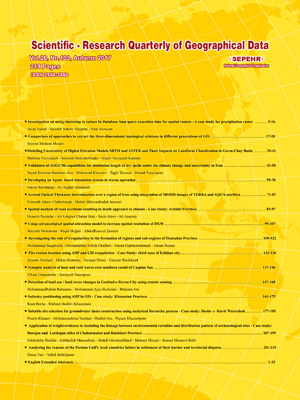Document Type : Research Paper
Authors
- Fakhraldin Shaikhi 1
- Zabihallah Masoudinia 2
- Mahdi Gholamalifard 3
- Mohsen Mirzaii 4
- Rasoul Mousavi Bidli 5
1 Ph.D. Student, Isfahan University
2 دانشجوی دکتری باستان شناسی دانشگاه هنر اصفهان (نویسنده مسئول)
3 Assistant professor, Tarbiat Modarres University
4 Ph.D. Student, Malayer University
5 M.A.Tarbiat Modarres University
Abstract
Abstract[1]
Information on archeology and the distribution of ancient sites for the possibility of analyzing the past societies and the remaining remnants of them is of particular importance. But unfortunately, our information about ancient sites and their pattern of distribution is often accompanied by flaws and uncertainty.In the present study, statistical techniques and geographic information systems have been used to obtain the relationship between environmental variables (including: distance from springs, distance from permanent rivers, distance from aqueducts and wells, distance from bridle paths and distance from cemeteries) which have decisive and influential on the pattern of human population distribution in different ages.Among the statistical techniques, the weight-evidence functions are able to use the knowns and the unknowns of the user about the occurrence of a phenomenon (ancient locations and sites) and by processing hypotheses from the knowns and limiting the hypotheses cases where there is no accurate knowledge and finally the weight composition of the inputs, display the information defect in the final results.ROC statistics were used to assess the accuracy of modeling.To evaluate the accuracy of modeling, ROC statistics have been used and the results of the research indicate that this model has the ability to predict favorable areas of unknown ancient locations and sites in Boroujen and Lordegan in provinces of ChaharmahalvaBakhtiari province (ROC=0.89).This approach is an appropriate solution for decision making and management in the field of archaeological research and the results of this research can be used for the management and planning of surveys, and archaeological excavations, prioritizing the existing susceptible areas in terms of ancient importance and ultimately saving on time and economic costs.
[1] - به دلیل کیفیت نامناسب ترجمه (چکیده مبسوط انگلیسیِ دریافتی) نشریه، به ناچار اقدام به ترجمه مجدد متن مختصر چکیده فارسی و انتشار آن به جای چکیده مبسوط انگلیسی نموده است.
Keywords

